Can You Paint Over Chrome? It's Not Easy, But Yes
Author: Rick Worst | Editor: Omar Alonso
Review & Research: Jen Worst & Chris Miller
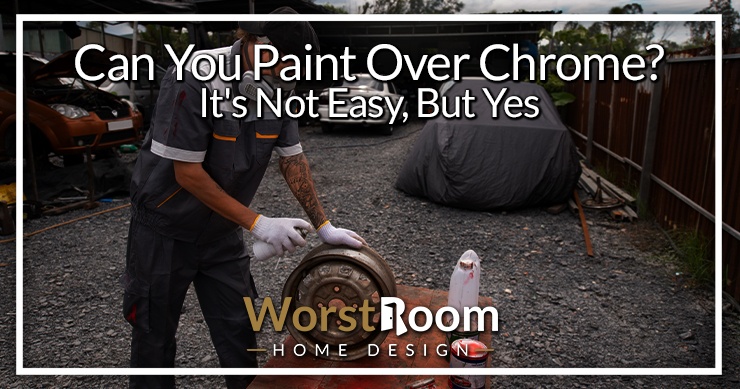
Can you paint over chrome and get a decent result? This material is notorious for being challenging to paint, with stories of paint peeling and flaking just a few weeks after application. Can chrome be painted by a regular person and not a pro? Is there any method that works?
Can You Paint Over Chrome?
Yes. You can paint over chrome with the right method, preparation, and paint. To do it successfully requires you to follow our step-by-step process to success.
A Step-by-Step Guide to Painting Over Chrome
Manufacturers chrome-plate steel to protect it from the elements. It doesn’t rust as readily as other materials, making it a good choice for outdoor and industrial applications. If the underlying steel starts to corrode and rust, it shows up in the chrome finish, requiring reconditioning.
Follow this guide to restoration using a high-quality paint job that lasts. Here is how to paint over chrome:
1) Secure Your Supplies
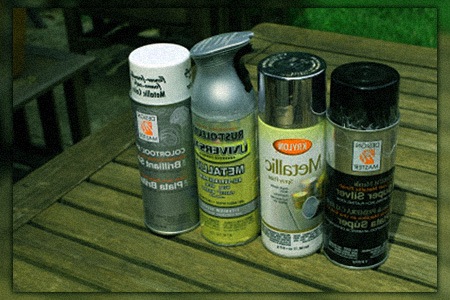
Start the process by gathering your supplies for the task. You’ll need the following for the job:
- Automotive paint primer
- Automotive latex or enamel paint
- Paint sealant
- Rollers and brushes or a paint sprayer
- Toothbrush
- Paint tray
- Painters tape and plastic sheeting
- Dish soap
- Rags
- Welding putty or liquid metal filler
- Putty knife
- 160 & 320-grit sandpaper
- Orbital sander or sanding block
- Buffing cloth or pad
- Close-fitting sanding goggles
- N-95 respirator
- Hammer
You’ll need the metal filler/putty and hammer if you have to do a repair job on a corroded chrome surface. We recommend purchasing automotive paints and primers as they offer the best adhesion to the surface.
2) Prep the Job Area & Materials
Can you paint over chrome? Yes, but you must first create a proper surface for the paint to bind to. Take the chrome piece out into the open or a well-ventilated area with a shop ventilation system. The chrome particles released into the air when sanding irritate the respiratory system if inhaled.
The chemical vapors created when applying the primer and paint also cause this effect, so ensure you have plenty of fresh air around you for the fumes to dissipate.
If you’re painting around areas, like your driveway, that you want to preserve from paint drips and spills, lay plastic sheeting on the floor and secure it with tape. It catches the paint, preventing a mess that’s challenging to remove.
3) Cleanup Your Chrome
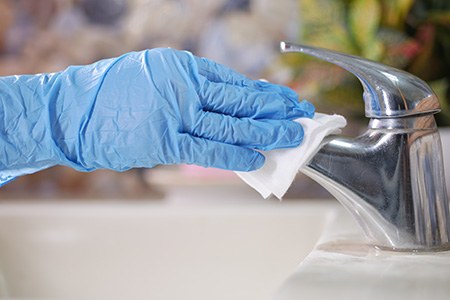
Start the job by mixing some dish soap with warm water. Wash the chrome plates or fixtures to remove surface dirt. If there’s extensive corrosion, you’ll need to use an abrasive cleaner before washing it with soap.
We recommend using a toothbrush to remove stubborn rust in crevices. After washing, rinse thoroughly and dry the chrome off with a rag. Inspect the piece after drying to ensure you cleaned it properly.
4) Sand the Chrome
Don your respirator (we recommend an N-95 mask) and your safety goggles. Use the 160-grit sandpaper to sand the surface. Strap the sandpaper to a sanding block or use a random orbital sander for the best results. Other types of sanders may leave detectable patterns of scratches.
When you’ve sanded away most of the damaged chrome, switch to the 320 grit to create a smoother finish.
Sanding is essential to scuff the surface, allowing for better adhesion of your primer. When you’re done sanding, wipe it down with a clean rag to remove the sanding dust. You can't skip this step as it's crucial for how to paint chrome. Please take your time with it and your final result will be that much better.
5) Make Your Repairs
If the surface has gouges or cracks, repair them using filler products. Welding putty or liquid metal fillers are your best option.
Wear your gloves and follow the manufacturer’s instructions for mixing and applying the fillers. Smooth them out using your putty knife.
Remove the bends or dents in the sheeting using the face part of your hammer. Place the chrome underneath a flat, hard surface and use your hammer or mallet to beat the interior of the chrome sheet into shape.
Follow the sanding procedure to smooth out scratches again after filling any divots with putty. Rinse the chrome sheets or fixtures with fresh water, air dry, and buff with a rag.
6) Prime the Surface
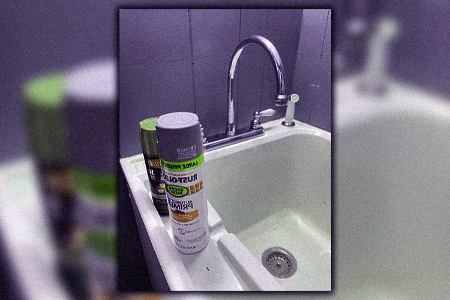
Ensure the chrome surface is dry before starting the primer process. Automotive types of primer offers better adhesion to the chrome than using paint alone. If you don’t prime it, you’ll find the paint cracks and peels after a few weeks. Primer also allows for better paint coverage, saving you on paint costs.
Can you paint over chrome? Yes, but we recommend using two to three light coats of primer before adding your paint. You can use a brush or roller to apply the primer, but we recommend a sprayer for the best results. You can hire a sprayer from a plant & hire a company if you don’t own one.
If you’re spraying, keep the nozzle around a foot away from the surface. Use a sweeping motion when spraying. This strategy prevents running that dries into bumps and ruins the visuals of the paint job. Start at one end of the sheet and sweep across to the other end.
If you decide to forego the sprayer and want to use a brush or roller, that’s fine. However, ensure you use light coats and spread the primer properly to prevent runs or drips.
The primer takes around 24 hours to dry and cure, so take the sheet into an area away from dust and debris in the air that might settle on the primed surface and cause a sandy effect after drying.
Drying time will vary depending on the weather conditions in your area, with humid, cold regions requiring longer for a full cure on the primer.
After the primer is dry, lightly sand it with 320-grit sandpaper. This action allows for better paint adhesion to the primed surface.
Don’t and too hard, or you’ll remove the primer. Wipe the surface clean after sanding.
7) Apply Paint
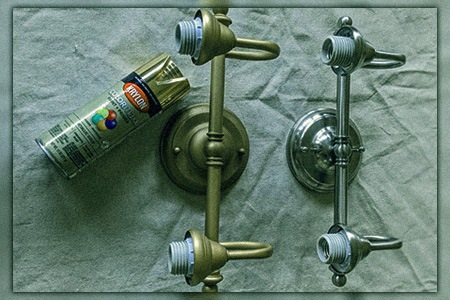
We recommend using automotive paint for the task because it offers the strongest bond to the primer. Paint the surface using the aforementioned spraying or brush/roller strategies. Ensure you allow for full drying between each coat for optimal adhesion.
Depending on the paint brand, you might need two or three coats to see the complete color effect appear on the painted surface.
8) Seal the Paint Job
This step is optional, but we recommend it if you want the longest-lasting results from your paint job. Sealing prevents UV rays from fading the paint and stops scratching and chipping of the painted surface, so it’s worth the extra expense and effort.
Sealants, or “clear coats,” come in flat or glossy finishes, so choose the one that suits your application. Once again, you have the option for sealing using the sprayer, roller, or paintbrush. Follow the previous directions for using them.
After applying your sealer, remove the plastic and tape from the work area and wait a few days for the paint and sealer to fully cure before remounting the finished product.
After a week, buff the sealed or painted surface using a buffing cloth or orbital sander with a buffing plate to bring the paint or sealer to a full shine. So, can you paint over chrome? Yep, and that's how you do it.
What Is the Best Paint Choice for Chrome?
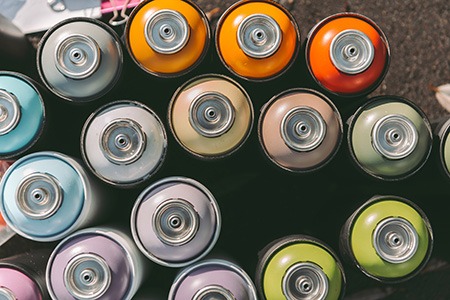
Chrome is a popular material for decor applications due to its shiny, elegant appearance. However, the sheen of the metallic surface is challenging to pain properly. You’ll need the right paint for the task, or it’s going to crack and peel, wasting your time and money.
Can you paint chrome? Yes, and here are the ideal high-quality paints for refinishing chrome surfaces.
Epoxy-Based Paints
Expoxy-based paints are our top choice for chrome painting projects. After the paint dries, it forms a durable, rock-hard surface with a good, weatherproof seal that’s resistant to wear and tear. Epoxy paints are resistant to corrosion, chemicals, abrasion, and shocks.
You’ll get an impressive finish that lasts for years to come, and it works on flat and shaped surfaces. However, epoxy-based paints are the most expensive choice for your reconditioning project.
Urethane-Based Paints
Painting chrome isn’t easy and requires special care during the reconditioning and painting process. Urethane-based paints are our second choice for the job because they offer long-lasting finishes with good resilience to the elements and damage.
Urethane-based paints have excellent UV resistance, so they’re the best option if you don’t plan on using a sealant to finish the job. It’s a good weatherproof choice for outdoor projects that get sun exposure.
Urethane paints offer a glossy finish, so they aren’t the best choice if you want a flat look for the paint job.
Enamel-Based Paints
Our last options for painting chrome are an enamel-based paint. You get a bright, glossy finish for a great visual standout when mounting the sheet or fixtures. Like the other paints mentioned, you get a hard, scratch and damage-resistant finish, ideal for outdoor applications. You'd might use it to customize the appearance of whatever types of lug nuts you have on your car wheels, for instance.
Enamel paint has excellent durability and weather resistance, providing a rust and corrosion-resistant surface. It offers excellent adhesion, making it less likely to peel than most other paint types. It’s also an affordable paint and readily available online or at hardware stores.
So, Can You Paint Over Chrome? You Can!
Use our step-by-step guide to painting chrome for the best results with your project. It’s essential to follow all the steps correctly for a paint job that lasts. If you miss a step, you’ll end up with the paint cracking, peeling, and flaking away.
Can you paint over chrome? If you’re not handy, consider hiring a professional to do the job. It might add to your project costs, but at least you’ll get a finish offering the longest service life possible for the painted surface.



